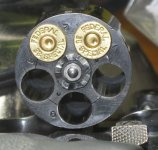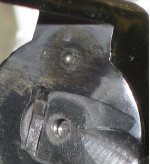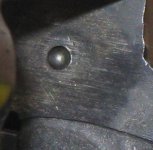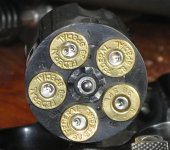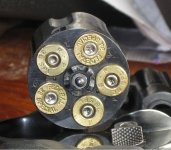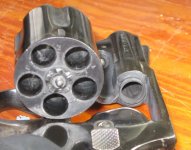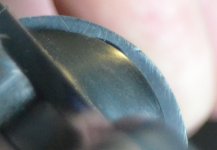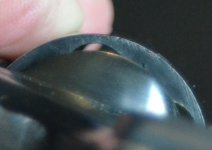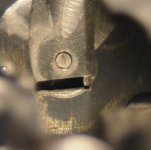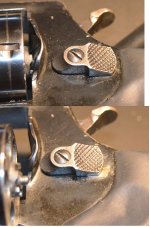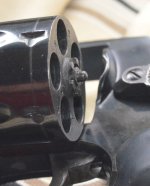You are using an out of date browser. It may not display this or other websites correctly.
You should upgrade or use an alternative browser.
You should upgrade or use an alternative browser.
Its that time once again to read those primer leaves
- Thread starter Ozzieman
- Start date
Back in the early 1970's my new Ruger Super Blackhawk made some off center hits.Even out on the brass. The cylinder latch was not working correctly .The gun went back to Ruger.They took care of it.
If the gun is functioning properly,the hand pushes on the pawl rotating the cylinder as the hammer comes back to full cock.
The locking bolt is released to rise up and engage the locking recess in the cylinder.This lockup has already occurred when the hammer reaches full cock.
The locking bolt is engaged in the index notch before the trigger is pulled.
Unless its not working. So the locking bolt controls the "side to side" or 3 oclock/9 oclock offset.
With a floating,hammer mounted firing pin,potentially you could see vertical fp offset.6 oclock or 12 oclock. To be noticeable,something is probably worn.
It could possibly occur on a loose/worn DA gun that the crane and cyl latch are sloppy. It can happen with dirty ammo...If you eject empties muzzle down,unburned powder can get between the crane and frame,acting as a shim.
Put a sharpy index mark on the rim and load then into the cyl indexed at 12 oclock .From there you can see the direction of offset.
If the gun is functioning properly,the hand pushes on the pawl rotating the cylinder as the hammer comes back to full cock.
The locking bolt is released to rise up and engage the locking recess in the cylinder.This lockup has already occurred when the hammer reaches full cock.
The locking bolt is engaged in the index notch before the trigger is pulled.
Unless its not working. So the locking bolt controls the "side to side" or 3 oclock/9 oclock offset.
With a floating,hammer mounted firing pin,potentially you could see vertical fp offset.6 oclock or 12 oclock. To be noticeable,something is probably worn.
It could possibly occur on a loose/worn DA gun that the crane and cyl latch are sloppy. It can happen with dirty ammo...If you eject empties muzzle down,unburned powder can get between the crane and frame,acting as a shim.
Put a sharpy index mark on the rim and load then into the cyl indexed at 12 oclock .From there you can see the direction of offset.
Ozzieman I know the possible issues this kind of a primer strike can be but has anyone ever seen a revolver that hits the primer like this? That was normal?
Personally I wouldn't shoot it till I had it checked. Which for a timing issue could be done in seconds with a rod of some kind.
I was just given >400 38 special cases. Federal once fired and every one, every single one has the same indention on the primer. The case itself looks normal with no bulges or strange markings.
I don't know the gun but after seeing them I sent an e mail out to the owner on what kind of gun it is.
If the round fired and there is no metal/lead shaving due to the cylinder being out of time the cylinder is not out of timing. And then there is the chance there is ware so I suggest someone rock the cylinder back and forth. I have never seen a firing pin strike a primer off center in a wheel gun. And then there are those slide type pistols that rake the primer when the barrel drops.
F. Guffuy
Last edited:
Pretty much my point.
If there is motion and firing, then its way off and should be shaving lead and splattering out the cone.
Realistic the cylinder is still stopped, it can only go so far off center and not strike the primer and the firing pin is going to quasi latch it in place.
Need the gun, should be most interesting .
We may have to pitch in and buy gas so he can go GET the gun.
If there is motion and firing, then its way off and should be shaving lead and splattering out the cone.
Realistic the cylinder is still stopped, it can only go so far off center and not strike the primer and the firing pin is going to quasi latch it in place.
Need the gun, should be most interesting .
We may have to pitch in and buy gas so he can go GET the gun.
The gun is a Taurus 85 in 38 special
SN: HA980XX
Over all on a first inspection the gun hasn’t been beaten or shot that much. She is the 3rd owner.
http://www.taurususa.com/find-model.cfm
Taurus model by serial number look up.
Model HG-M85-B3 Production year 1988.
Further inspection issues.
1. With the hammer down and trigger released there is a lot of play in the cylinder. Both in rotation and end shake.
2. With the trigger pulled with cylinder locked the amount of play is essentially the same.
3. Photo “New Prim 1 hit double action” these cases were sized and new primers placed in the gun and shot double action. You can see from the photos that the hammer hits were all over the place but always to one side.
4. The next two photos are “firing pin and firing pin 2” These are close ups of the firing pin with the hammer down and trigger pulled. What is noticeable is the discoloration of the frame. There are two distinct circles. The outer darker one I am sure is the case. The inner one is the primer pocket of the case. It’s a little hard to tell but I assure you the primer pocket is shifted to the left of the firing pin.
5. I didn’t want to fire a bunch of primers so I took 5 of the old cases with the offset hit and just blank fired them. The first photo marked “single action” each case was struck 3 more time for a total of 4.
6. Is the same as 5 but was fired “Double action”. I should have taken the photo first or set all the primers the same then fired the gun. This I will do tomorrow when I have time.
I realize that these multiple hits really don’t mean that much but it was done more as an experiment to see if the primers have a shot gun pattern of hits.
7. When fired double action with empty chambers there is a good amount of drag on the cylinger which changes as the cylinder rotates.
SN: HA980XX
Over all on a first inspection the gun hasn’t been beaten or shot that much. She is the 3rd owner.
http://www.taurususa.com/find-model.cfm
Taurus model by serial number look up.
Model HG-M85-B3 Production year 1988.
Further inspection issues.
1. With the hammer down and trigger released there is a lot of play in the cylinder. Both in rotation and end shake.
2. With the trigger pulled with cylinder locked the amount of play is essentially the same.
3. Photo “New Prim 1 hit double action” these cases were sized and new primers placed in the gun and shot double action. You can see from the photos that the hammer hits were all over the place but always to one side.
4. The next two photos are “firing pin and firing pin 2” These are close ups of the firing pin with the hammer down and trigger pulled. What is noticeable is the discoloration of the frame. There are two distinct circles. The outer darker one I am sure is the case. The inner one is the primer pocket of the case. It’s a little hard to tell but I assure you the primer pocket is shifted to the left of the firing pin.
5. I didn’t want to fire a bunch of primers so I took 5 of the old cases with the offset hit and just blank fired them. The first photo marked “single action” each case was struck 3 more time for a total of 4.
6. Is the same as 5 but was fired “Double action”. I should have taken the photo first or set all the primers the same then fired the gun. This I will do tomorrow when I have time.
I realize that these multiple hits really don’t mean that much but it was done more as an experiment to see if the primers have a shot gun pattern of hits.
7. When fired double action with empty chambers there is a good amount of drag on the cylinger which changes as the cylinder rotates.
Attachments
7. When fired double action with empty chambers there is a good amount of drag on the cylinger which changes as the cylinder rotates.
8. The last photo (barrel) shows the forcing cone. Note in the last +8 years and no idea of how many rounds the gun has never been cleaned. Either side of the forcing cone shows no shaving.
9. I ran a dowel rod down the barrel with both the trigger pulled and released. I can see where the cylinder is off set. I cannot make contact to the end of the cylinder. I did not try to turn the cylinder in this due to lack of 3 hands.
8. The last photo (barrel) shows the forcing cone. Note in the last +8 years and no idea of how many rounds the gun has never been cleaned. Either side of the forcing cone shows no shaving.
9. I ran a dowel rod down the barrel with both the trigger pulled and released. I can see where the cylinder is off set. I cannot make contact to the end of the cylinder. I did not try to turn the cylinder in this due to lack of 3 hands.
Attachments
The double-striking the primer thing...You can do what you want,but on the first strike,no side loads are put on the firing pin.Not so with the second strike.Its like trying to move a drilled hole over 1/2 a hole.I bent a 1911 fp that way once.It was a Wilson or Ed Brown quality.
I think I see your problem. Someone has made a habit of being "cool" and slamming the cylinder shut with a quick rotation of the wrist.
The cylinder latch recess is battered egg shaped,then the burr was dressed off.The hole is egg shaped.
The tip of the base pin that engages that hole is bent.
Post 25.the first two pictures below item (7)
I would suspect the crane may be tweaked,too
I think I see your problem. Someone has made a habit of being "cool" and slamming the cylinder shut with a quick rotation of the wrist.
The cylinder latch recess is battered egg shaped,then the burr was dressed off.The hole is egg shaped.
The tip of the base pin that engages that hole is bent.
Post 25.the first two pictures below item (7)
I would suspect the crane may be tweaked,too
Last edited:
Those are better pix!
That hole looks better.
If I understand how the gun works,the round plunger in that hole is part of the cylinder latch,but it does not lock anything.It serves to depress the plunger in the end of the base pin,the "axle" through the wheel.
So if you look to the base pin,the plunger in the end of it,actually,start with the crane to frame pivot,and work your way through the crane,base pin,to the cylinder latch plunger protruding from the base pin,How much cumulative play?
Then look at the cylinder latch that pops up out of the frame under the cylinder,to fit the notches in the cylinder.
The crane and base pin,and latch define the axis of rotation for the cylinder.That axle is either stable,or its not. That would be one source of movement.
The other source is the index,or rotation around the base pin.The "clocking"
That is controlled by the locking bolt,its window(clearance) in the frame,or the bolt to cylinder notch clearance.
Those are the mechanical features that control the cylinder and its alignment.
From what I can see,the axis of rotation for the cylinder,via the base pin,is not stable for whatever reason.
It appears your firing pin is stable and located on the breech face.Thats not the problem.
That hole looks better.
If I understand how the gun works,the round plunger in that hole is part of the cylinder latch,but it does not lock anything.It serves to depress the plunger in the end of the base pin,the "axle" through the wheel.
So if you look to the base pin,the plunger in the end of it,actually,start with the crane to frame pivot,and work your way through the crane,base pin,to the cylinder latch plunger protruding from the base pin,How much cumulative play?
Then look at the cylinder latch that pops up out of the frame under the cylinder,to fit the notches in the cylinder.
The crane and base pin,and latch define the axis of rotation for the cylinder.That axle is either stable,or its not. That would be one source of movement.
The other source is the index,or rotation around the base pin.The "clocking"
That is controlled by the locking bolt,its window(clearance) in the frame,or the bolt to cylinder notch clearance.
Those are the mechanical features that control the cylinder and its alignment.
From what I can see,the axis of rotation for the cylinder,via the base pin,is not stable for whatever reason.
It appears your firing pin is stable and located on the breech face.Thats not the problem.
I think HiBC is right about this being cylinder flip closing damage.

We can't see it well from the photo angles, but does the pin in the center of the cylinder protrude far enough to get into the hole and have its full width there? Is the cylinder latch retracting far enough to let it all the way in?

We can't see it well from the photo angles, but does the pin in the center of the cylinder protrude far enough to get into the hole and have its full width there? Is the cylinder latch retracting far enough to let it all the way in?
With the cylinder out I can move the latch in and out and it is smooth through its full movement.Is the cylinder latch retracting far enough to let it all the way in?
With the cylinder in, the latch retracts almost its total amount of travel away from the cylinder. So I would say yes it is retracting far enough.
Attachments
FrankenMauser
New member
That is going to be my recommendation to the owner.It's time to retire that revolver and upgrade to something better.
I like troubleshooting the failure. I was asked about Taurus's life time warranty so I just looked it up. The last line just about sums up this guns future.
The one point in all of this, I cant think of any way this gun could be in this condition other than doing a Jack Web on it.
To bad it doesn't have a number counter on it recording the number of times the cylinder was slammed shut.
Thanks to every one for the knowledgeable input and help on this gun.
The Taurus Unlimited Lifetime Repair Policy™ is just that. The lifetime of the gun...not the buyer. This is the first warranty of its type in the industry. No other manufacturer has the confidence to extend this kind of offer. Except us. We know how good our guns are, and we are not afraid to stand behind them... for a lifetime.
This warranty does not cover grips, sights, accessories, cosmetic defects after one year, or damage caused by customer abuse at any time.[/I] Taurus will not be responsible for these items.

